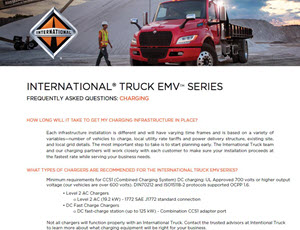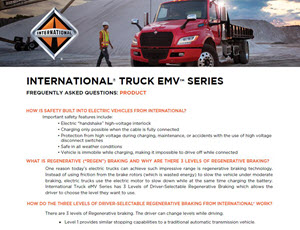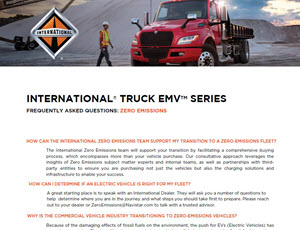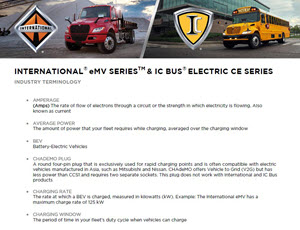ZERO-EMISSION FUTURE QUESTIONS
Frequently Asked Questions about Zero Emissions
General Questions
-
How can the Navistar Zero Emissions team support my transition to a zero-emissions fleet?The Navistar Zero Emissions will support your transition by facilitating a comprehensive buying process, which encompasses more than your vehicle purchase. Our consultative approach leverages the insights of Zero Emissions subject matter experts and internal teams as well as partnerships with third-party entities such as In-Charge Energy and OneH2, to ensure you are purchasing not just the vehicles but the charging solutions and infrastructure that enable your customers’ success.
-
How can I determine if an electric truck is right for my fleet?A great starting place is the TCO Calculator. The Zero Emissions team can also help: Schedule a visit HERE.
-
Why is the commercial vehicle industry transitioning to zero-emissions vehicles?Because of the damaging effects of fossil fuels on the environment, the push for EVs has never been greater. The transition to zero-emissions vehicles will help to reduce the impact of fossil fuel use on climate change, air, and water quality. Depending on the type of vehicle, battery electric trucks and buses are up to 3.5 times more efficient than diesel and natural gas vehicles at normal speeds. (SOURCE: https://ww2.arb.ca.gov/resources/documents/battery-electric-truck-and-bus-energy-efficiency-compared-conventional-diesel) With fewer parts to replace, maintenance on each vehicle will also be greatly reduced.
-
How do hydrogen and battery electric vehicles compare with diesel-powered trucks and buses?Simply put, zero-emissions vehicles are quicker, quieter, and cleaner, creating a better experience inside the vehicle and out, while producing zero tailpipe emissions. Furthermore, EV trucks cost less in the long run because they have less parts and require less maintenance
-
How do battery electric vehicles work and what advantages do they offer?High-voltage batteries power the truck, communicating with software that sends energy to an electric motor. Battery electric vehicles have zero tailpipe emissions.
Currently, battery electric vehicles are ideally suited for operations such as:
- Regional haul day cab routes
- Vehicles that return to the depot at the end of the day/shift for charging, example, school buses
- Areas where there are federal or state incentives for infrastructure and fleet investments
- Dense urban areas where total cost of ownership can be on par with traditional powertrains
-
Will the electrical grid be able to support this transition?Necessary infrastructure upgrades are in process. Most utilities are investing in grid updates and are preparing for the future of zero-emissions vehicles. As for the present, commercial EVs are unlikely to overload the grid, since most charging takes place at night, when electricity demand is lowest.
-
Do first responders know how to handle electric vehicles in case of fire or a crash?
During the delivery of the vehicle, International Truck & IC Bus is committed to help train local first responders of the EV bus being put into service in their area. We have published documents on the NFPA (National Fire Protection Agency) documenting where the safety switches and cut points on our vehicle. The battery chemistry does not require special chemical extinguishers to help fight the fire.
-
Are public funds available?Yes, there are a number of grants available by state and county depending on your located/area of responsibility (AOR). Tax credits are also very important when it comes to regional haul - the more miles driven the more credits returned. The Zero Emissions Grants Team can help identify Grants that will work for your needs.
-
Will the grid infrastructure be able to handle the introduction of EVs?While infrastructure varies state to state, it is vitally important that if you plan to add EVs to your fleet, to engage now and start talking to your utility company to gauge your energy requirements now and in the long term.
-
Will there be a standard charging system available?We are currently collaborating with partners on standardizing charging capabilities and will have a clearer picture within the next 12 months. Navistar is committed to ensure that our vehicles work with a number of chargers for mixed fleet solutions.
Product Questions
-
How is safety built into electric vehicles from International and IC Bus?
Important safety features include:
- Electric “handshake” high-voltage interlock
- Charging only possible when the cable is fully connected
- Protection from high voltage during charging, maintenance or accidents
- Safe in all weather conditions
- Vehicle is immobile while charging: Impossible to drive off while connected
-
What is regenerative (“regen”) braking? Why do Navistar’s electric vehicles provide 3 levels of regenerative braking?One reason today’s electric trucks and buses can achieve such impressive range is regenerative braking technology. Instead of using friction from the brake rotors (which is wasted energy) to slow the vehicle, under moderate braking, electric trucks and buses use the electric motor to slow down, while at the same time, charging the battery.
-
The vehicles from International® take this concept a step further by employing three levels of driver-selectable regenerative braking:
- Level 1 provides similar stopping capabilities to a traditional automatic transmission vehicle.
- Level 2 provides a moderate amount of regenerative braking.
- Level 3 allows for one-pedal style driving and will slow the vehicle to a few miles per hour with the driver using the service brake to bring the vehicle to a complete stop.
-
How long does an EV battery last?Although factors such as battery composition, temperature, charging rate, etc., affect EV battery performance, it is not unusual for them to last the life of the vehicle. For additional peace of mind, International® offer extended battery warranties.
-
What is the estimated range of the International® Truck eMVTM Series?Estimated range varies on several factors, but most vehicles achieve a reliable range of 135 miles per charge.
-
What factors can affect range?Climate, terrain, use of regenerative braking, AC/Heat usage, and vehicle use may all affect the range. The Zero Emissions team can help with route consultation to determine range for your application.
-
What is the International® Truck eMVTM Series payload capacity at various frame lengths?
The eMV is roughly 3500 pounds heavier than a similar diesel spec in any frame length. Payload capacity would be reduced by 3500 - 4,000 pounds for BEV vs. diesel. Actual weights can be provided by creating a specification.
-
What is the total battery capacity of the International® Truck eMVTM Series?
210 kWh
-
What is the purpose of the Battery Thermal Management system?Our purposely designed battery thermal management system is focused on keeping the batteries at an optimal temperature range to reduce the risk and protect battery integrity.
-
Does all high voltage repair have to be done at the dealership?Yes, all International Dealers are required to become EV Certified to work on high voltage. This certification requires techs to attend in-person, hands on training.
-
What happens after my International® Truck eMVTM Series is delivered?Our dedicated Zero Emissions Deployment team will assist with dealership staff, customer, driver, and first responder training to ensure that all parties know how to properly operate, maintain, and charge their vehicle.
-
Are there any concerns with washing electric vehicles?There is no issue with washing your electric vehicle. It is advised to avoid high pressure spray on electrical components, especially directly into connectors. Vehicles should be unplugged from chargers during washing.
-
Where is the charge port located on the truck?The default charger port location is currently right-side mount, in March 2023 will default to left-side mount. Optional rear mount will be available later this year.
Charging Questions
-
How long will it take to get my charging infrastructure in place?According to the North American Council for Freight Efficiency (NACFE), every charging installation faces a variety of variables—number of trucks to charge, local utility rate tariffs and power delivery structure, existing site, and local grid details. The Zero Emissions team and our charging partner will work closely with each customer to make sure your installation proceeds at the fastest rate while serving your business needs. More information from the NACFE Study can be found here
-
What types of chargers are available for the International® Truck eMVTM Series?Any charger with a minimum 600 volts will work. That includes:
- Network-capable chargers
- Level 2 AC (19.2 kW) - 1772 SAE standard connection
- Minimum for overnight charging (not recommended)
- DC charging station (30 kW) - Combination CCS1 adapter port
- More efficient than AC, recommended minimum
- DC fast-charge station (up to 125 kW) - Combination CCS1 adapter port
- More efficient than AC, fastest option
- DC public fast-charging (up to 125 kW)
-
How long does it take to charge a commercial vehicle?AC charging typically takes overnight, DC fast-charging, in just a few hours. Environmental factors such as battery age and condition and ambient temperature are additional factors. The Zero Emissions team will work with our customers to recommend the best installation for your charging needs.
-
Is there any issue with charging your vehicle to 100% each day?There are engineered restrictions in place, so charging to 100% each day will cause no issue and is recommended for International Truck and IC Bus Products.
-
Why should my in-house chargers be network-capable?Network capable chargers can receive over-the-air (OTA) updates to diagnose charging issues. They also allow the fleet manager to monitor charging status.
-
What percentage of capacity can we use daily without damaging the battery?
The software already limits the battery consumption to adhere to expected battery life. Nothing incremental needs to be done to prevent damage of the battery.
-
How long does it take to charge an International® Truck eMVTM Series?
This will vary depending on the type of charger and external environment. Below is estimated charge times with chargers. Our products have a charging speed of 125kW. All estimates below are based on room temperature for the 210 kWh.
- 19.2 kW AC EVSE = 12 hours
- 30 kW DC charger = 7.5 hours
- 60 kW DC charger = 4 hours
- 120 kW DC charger = 2 hours
- Above 120 kW DC charger = 2 hours
-
What are Public Charging Options for International® Truck eMVTM Series?
- The International® Truck eMVTM Series can be charged at some public chargers, but not all. Not all chargers have been tested for compatibility with Navistar vehicles. Furthermore, the 600-volt architecture on our vehicles is higher than many vehicles, and not all chargers are built to charge a 600-volt architecture.
- Apps for finding public chargers are not set up to filter for chargers which will charge the International® Truck eMVTM Series. However, there are ways that you can filter which will help locate the chargers that are most likely to be compatible.
- If a charger will charge an 800-volt vehicle, then it is possible that it will charge the International® Truck eMVTM Series. Apps that are used for finding public charging stations can be filtered to find chargers for those vehicles.
- Use these filters on charging apps to locate public chargers that are most likely to charge an International® Truck eMVTM Series:
- Porsche Taycan
- 50 kW minimum charge speed
- CCS connector
- Check PlugShare app to locate a charger: www.plugshare.com
-
How much does installing a charger cost?Charger and installation costs will vary, and there are many factors that contribute to the costs. Please reach out to the Navistar Zero Emissions team for more information.
-
How long does it take to install charging infrastructure?Each infrastructure project will vary in timeline due to location, available electricity, and local utility. Some projects will take 1-6 months, while some may take 12-18 months or more. The Navistar Zero Emissions team can help navigate the estimated timelines.
-
Is there a maximum charging rate on the International® Truck eMVTM Series?Yes, the vehicles have a max charging rate of 125kW
-
What is considered the optimal temperature for the batteries?The optimal temperature is around 70o F. The BTMS System is designed to maintain optimal temperature when the vehicle is in use or plugged into a charger.
Industry Terminology
-
AmperageThe rate of flow of electrons through a circuit, a.k.a. current
-
Average PowerThe amount of power that your fleet requires while charging, averaged over the charging window
-
BEVBattery-Electric Vehicles
-
CHAdeMO PlugA round four-pin plug that is exclusively used for rapid charging points and is often compatible with electric vehicles manufactured in Asia, such as Mitsubishi and Nissan. CHAdeMO offers Vehicle to Grid (V2G) but has less power than CCS and requires two separate sockets.
-
Charging RateThe rate at which a BEV is charged, measured in kilowatts (kW)
-
Charging WindowThe period of time in your fleet’s duty cycle when vehicles can charge
-
CircuitThe path along which electricity flows
-
Cloud-Based CommunicationsA wireless internet-based service carrying information on EVSE status, energy consumption, location, and payment for use between the owner and the user(s)
-
Combined Charging System (CSS)A type of connector that has been standardized. It combines two DC pins below the Type 2 AC connector and uses 3 of the Type 2 pins. This connector is found on most Type 2 BEVs
-
DCFCDirect current fast charge, usually stated as DC fast charge
-
Demand ChargeA fee applied to your greatest power draw during peak periods, on top of the rate that you pay for the energy ($/kW)
-
DistributionThe process of delivering power from transmission lines to the customer
-
Duty CycleThe portion of time during which a vehicle is operated
-
Energy ChargeYour baseline price of electricity, charged based on the amount of energy you consume ($/kWh)
-
EVSEElectric Vehicle Supply Equipment, or the charger unit
-
Fixed ChargeA fee covering the regulator-approved costs that the utility pays to supply your power such as distribution and transmission ($/month)
-
Flat RateA rate structure under which you are billed at a single price per kilowatt-hour consumed regardless of time, season, or application
-
GenerationThe process of producing electricity from a fuel source
-
HandshakeWhen you connect the plug into the vehicle the car will electronically handshake with the charging station. Once the handshake is made, the relay in the charging station will open, allowing electrons to flow to the car. When you disconnect the plug, the electricity stops flowing through the cable.
-
ICEInternal Combustion Engine
-
ISO 15118An international standard that outlines the digital communication protocol that an electric vehicle and a charging station should use to recharge an electric vehicle’s battery
-
kWOne kilowatt is equal to 1000 watts
-
kWhKilowatt-hour, a unit of measure for electrical energy. 1 kWh is the energy delivered by 1 kW of power for 1 hour
-
L1 ChargingLevel 1 charging uses a common 120-volt household outlet. Every electric vehicle can be charged on Level 1 by plugging the charging equipment into a regular wall outlet. Level 1 is the slowest way to charge an EV. It is too slow to be used for buses or commercial vehicles.
-
L2 ChargingLevel 2 charging is the most used level for daily EV charging of automobiles. Level 2 charging equipment can be installed at home, at the workplace, as well as in public locations like shopping plazas, train stations and other destinations. It may or may not be sufficient for commercial trucks and school buses, depending on the routes and environment.
-
L3 ChargingLevel 3 charging is the fastest type of charging available. Unlike Level 1 and Level 2 charging that uses alternating current (AC), Level 3 charging uses direct current (DC). It is the most common level of charging for school buses and commercial trucks.
-
Load ProfileA graph showing the amount(s) of power that your fleet requires over the course of a day
-
MeterA device that records the amount of power (kW) and energy (kWh)
-
MPGe(Miles per gallon equivalent) is the official metric that the EPA uses to measure the efficiency of alternative-fuel (including electric) vehicles. Just like regular MPG shows how far a car will travel on one gallon of gas, MPGe shows how far a vehicle will drive on 33.7 kWh of electricity – the energy equivalent of one gallon of gasoline
-
Networking ServiceAn internet-based service that allows an EVSE owner to analyze basic activity data from one or more EVSE
-
Peak ShavingA strategy to reduce power consumption during periods of high demand
-
Power Factor AdjustmentAn adjustment to your demand charge according to how efficiently your facility consumes power
-
Rate StructureA set of parameters used to define the prices that a customer may be charged at different times of the day
-
Regenerative BrakingRegenerative braking uses the vehicle’s motors to slow down the vehicle rather than the friction brakes. This sends energy back into the batteries for future use, which extends range.
-
Seasonal RateAdditional distribution fees covering the costs of weather stressors on the electric grid during winter or summer
-
SOCState of Charge - The equivalent of a fuel gauge for the rechargeable battery within an electric vehicle. SOC is measured by percentage points and ranges from 0% to 100%. This enables the EV driver to see how much charge their vehicle is currently holding.
-
SubstationA set of electric equipment that reduces high-voltage power to a voltage suitable for distribution to customers
-
Time-of-Use (TOU)A rate structure under which you are billed different prices for power you consume according to the time and season when it is consumed
-
TransformerA device that changes electricity from one level of voltage to another
-
TransmissionThe process of moving power in large quantities across long distances
-
VoltagePressure created by a difference in electrical charge between two points
-
WattOne watt is defined as the current flow of one ampere with voltage of one volt.
-
ZEVZero-Emission Vehicle
 EMV SERIES CHARGING FAQS
EMV SERIES CHARGING FAQS
 EMV SERIES PRODUCT FAQS
EMV SERIES PRODUCT FAQS
 ZERO EMISSIONS FAQS
ZERO EMISSIONS FAQS
 ZERO EMISSIONS TERMINOLOGY
ZERO EMISSIONS TERMINOLOGY